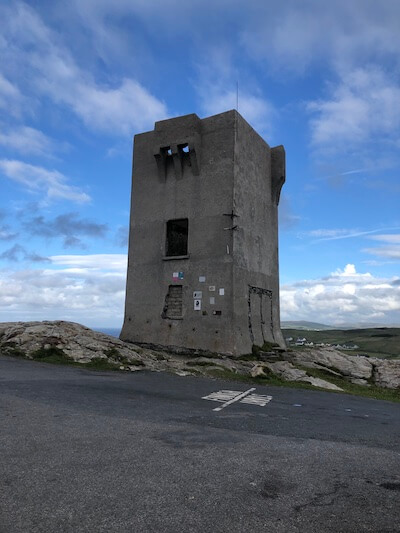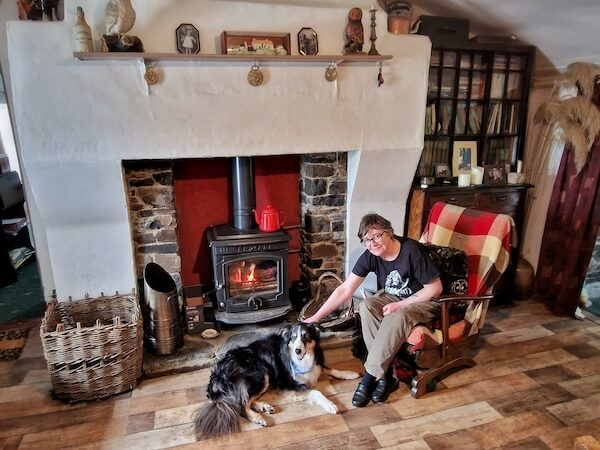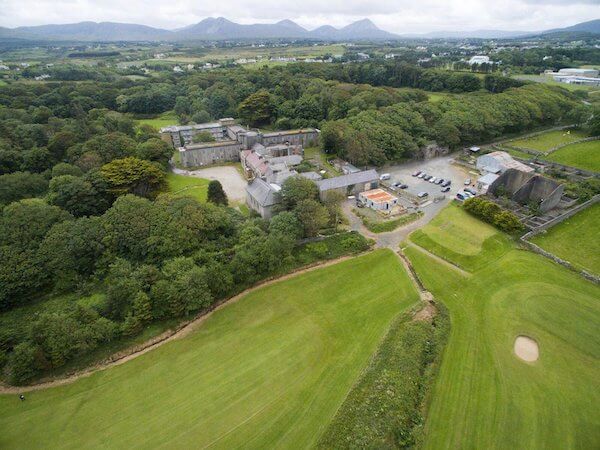Seeing all of County Donegal is impossible in two days and when I traveled to this part of Ireland recently, I knew that it would take many more days to see this incredible part of the Wild Atlantic Way.
 This blog post contains affiliate links, and I may earn compensation when you click on the links at no additional cost to you.
This blog post contains affiliate links, and I may earn compensation when you click on the links at no additional cost to you.
I knew, also, that the best way to see it was with photographer James O’Donnell and his canine partners, Iggy and Frida.
The dogs, 11-year-old Iggy and 9-month-old Frida are well known around the Falcarragh area, which is part of Donegal’s Irish-speaking region.
If you follow him on Facebook and Instagram, you’ll get an idea of how beautiful this area really is.
Falcarragh is surrounded by Muckish Mountain, with Mount Errigal a 15-minute drive away.
Falcarragh Back Strand is a short drive from the center of town and a favorite spot for the doggies to take a much-needed dip into the North Atlantic waters.
An Area Steeped in Folklore
The association with St. Colmcille also considered a patron saint of Ireland but not as well-known as Patrick, is strong in these parts of Donegal.
Colmcille, otherwise known as Columba, was born in Gartan, Co. Donegal, around 520 A.D.

Outside Falcarragh, you’ll find the ruins of a church that house a 9-foot (2.74 meters) St. Colmcille’s Cross.
The Colmcille Heritage Centre, which tells the story of St. Colmcille through beautiful banners, stained glass, illustrated panels, and artifacts, is only a 30-minute drive away.

A more primitive reminder of the saint’s connection to this area can be seen at Gartan-Rath, where you will find the remains of a monastery said to have been built by another O’Donnell, Manus, who was apparently a relative of Colmcille and also a prominent member of the O’Donnell clan during the 16th century.
The site, sitting on a hill, overlooks Lake Gartan.
If you believe in the power of holy water, be sure to bring an empty container so that you can gather some at St. Colmcille’s Well nearby.

You’ll find other strong associations with the saint at Shroove Beach on Inishowen Head.
It was there that Colmcille, known also as the patron saint of emigrants, set sail for Iona, the island off Scotland where he spent the remainder of his life.
Despite having established a monastery in nearby Derry/Londonderry in 562 A.D., Colmcille was more or less forced to leave his native land after a number of clerics and scholars threatened to excommunicate him after being accused of starting a war between two local tribes.
According to local legend, Columba is said to have wept as he looked back at his beloved Donegal for the last time.
Get Wifi in Ireland With Wifi Candy – take 10% off with code IOB2024
Memorial to a Great Love Affair
The Old Church at Dunlewey is a picture-perfect attraction that was definitely on my bucket list.
Located at the foot of Mount Errigal, the tallest of Donegal’s Derryveagh Mountain range, it’s a spot that James, Iggy, and Frida visit frequently.

The building that stands today is a lasting shrine that Jane Russell built for her late husband James Russell, the landlord of the Dunlewey estate.
Despite living a comfortable life in London, the couple decided to leave England in the mid-1800s and purchase land in Donegal, which would eventually become the large estate that they managed.
Russell died shortly after moving to the area, with his heartbroken widow building the church as a reminder of their time together in this remote part of the county.

Russell was laid to rest in a vault under the church floor.
The church is a dream for photographers to capture, with many images highlighting its white marble and blue quartzite stone.
Inishowen's Historical Monuments
Adding to County Donegal's numerous historical monuments is Grianán Aileach, an ancient stone fort that was once the seat of the High Kings of Ireland.

Visitors to the site might find the drive to the hillfort a little nerve-wracking, but we knew we were in good hands with James at the helm.
Once at the top, the views are amazing. The dogs were happy to scamper off to the fort, which is actually a recreation of the original structure.
Nonetheless, it's still impressive and it doesn't take much to imagine what might have taken place in this ancient place many centuries ago.
Book a B&B in County Donegal:
Stunning Views from the Mamore Gap
Driving with James and the “girls” through the Mamore Gap, on the Inishowen Peninsula, provided some of the most stunning views we had seen up until then.

The area is also home to Donegal's Magic Road, a slight downward slope that when navigated in neutral makes it seem as if one's car is going uphill.
There's one spot in the area that James loves to use as a backdrop when he is photographing the dogs.
At one time, the Gap was the only connection between the towns of Urris and Buncrana. During the 19th century, the area was a hotbed of illegal poitín manufacturing.
A Military Fort in a Breathtaking Location
If you know anything about the British conquest of Ireland throughout the centuries, you’ll discover that herculean efforts were made to fend off enemies, particularly the French during the Napoleonic Wars of 1803-15.
One of those defensive measures was the creation of Fort Dunree, a fortification-turned military museum and tourist attraction on the Inishowen Peninsula.

You can take a tour of the facility and later learn about the history of the fort and more in its military museum, which includes an array of military memorabilia.
Some of the artifacts in the museum’s Rockhill Collection come from Ireland’s defense forces that have served on United Nations, European Union, and NATO-led missions.

Medals that were awarded to members of the Connaught Rangers, an Irish infantry regiment of the British Army that recruited men primarily from the West of Ireland from 1881 until 1922, are also on display at the museum.
As well the military exhibits, there is also a space for art shows and displays at Fort Dunree.

On the day we visited, Deborah Stockdale, a textile artist, had just finished putting up her work in a new solo exhibition titled “Resurface” in the Mezzanine Gallery of Artlink.
Stockdale, an American native, has been living in the area for many years. She told us that her latest work represents reflections on her own work but is also related to society’s emergence from the pandemic.
She was more than happy to pose with Iggy as we looked around at her colorful textile work.
Exploring Malin Head
Despite the changeable weather, there’s really no place quite like Malin Head, Ireland’s most northerly point.
On a good day, you can see the Scottish hills in the distance.

For Star Wars fans, Malin Head is a real thrill. The area was one of the locations used for the filming of “The Last Jedi.”
In fact, the main road to Malin Head, originally called the R242, is now known as the “R2D2.”
From the Malin Head Viewing Point, we could see the enormous “Eire 80” sign on the ground, a relic from World War II.
From 1942 onward, these enormous signs were constructed all along the Irish coast enabling pilots to avoid accidentally landing on neutral Irish territory.

A signal tower built as a lookout by the British is also nearby.
If you hit the right weather conditions, the Northern Lights in this part of Ireland are a real treat.
On our way back to Falcarragh from a busy day touring, we stopped at the Doagh Famine Village.
The popular attraction tells the story of Irish life from the Great Famine in the mid-1800s through to the present day.
The most important elements of the village include the original thatched dwellings, the recreation of an Irish wake, and the eviction scene. Guided tours are available.

Unfortunately, the attraction was closed for the day when we got there, but that didn't stop James from snapping a picture of the dogs at the Hand of Doagh sculpture, which symbolizes “all that is good” about the human hand and its importance in greeting and welcoming others.
Culinary Delights Along the Way
No journey around Ireland is complete without stopping for a cup of tea somewhere, and we were in luck on our Donegal travels when we called into the home of Mary Shiels, a farmer and vegetable producer who lives in her family’s quaint 300-year-old cottage near the town of Malin.

Shiels was delighted to sit for pictures with Iggy and Frida as we relaxed in her comfortable kitchen.
Some of the other highlights of our culinary journey included an evening meal at Teach Coll in Magheroarty. In addition to the excellent cuisine, the views from this popular eatery are just breathtaking.

A quick stop at the Rusty Nail Crossconnell with Iggy was equally satisfying, as was the coffee and homemade pastries that we got at Kibben Koffee, a food truck located near Lough Akibbon in Churchill.
Other Things to Do in the Falcarragh Area
If you’re a golfer, be sure to stop at the affordable Cloughaneely Golf Club just outside the village.

The beautiful 9- and 18-hole course has fabulous views of Muckish Mountain, the Falcarragh Back Strand, and Horn Head. You can also see Mount Errigal in the distance.
Green fees are an affordable €20 during the week and €25 at the weekends from May through September. From October to April, weekday fees are €15, and weekend fees are €20. Visitors may play 9 or 18 holes at these fees.
About an hour’s drive south in Ardara you’ll find the Sliabh Liag Distillery (pronounced Slieve League), makers of the popular Silkie, the first legally distilled whiskey in Donegal in almost 200 years.

The name is a reference to the Silkies of the Donegal coast, which are a part of local folklore and could be considered the county's version of a mermaid.
Iggy is their leading brand ambassador helping to promote this local Donegal business far and wide. The double distilled single malt and triple distilled peated single malt matured in sherry casks is a nod to the type of whiskey made in Donegal years ago. It can be found across Ireland and in most U.S. states.
Follow the distillery on Instagram and Facebook and the Silkie brand on social media as well (Instagram and Facebook).
If you have the time, a visit to Tory Island is a must. Ireland's most remote offshore island is a haven for artists and nature lovers. You can get a glimpse of it from the Back Strand in Falcarragh.

Ferries to the island operate on a regular basis during the summer and at other times of the year.
Is Donegal on your list of places to visit in the future? Let me know in the comments below.





